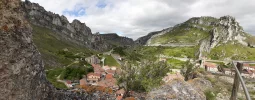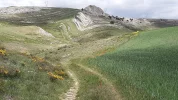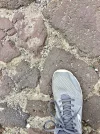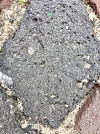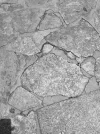- Time of past OR future Camino
- VdlP(2012) Madrid(2014)Frances(2015) VdlP(2016)
VdlP(2017)Madrid/Sanabres/Frances reverse(2018)
When I was a boy, maybe aged 12, I was given as a Christmas present this book.

A satisfyingly hefty book about the history of the planet.
My parents knew I was interested in rocks and fossils, and this book certainly fed my appetite. There was of course a chapter all about volcanoes, and included in this was full page colour plate of the chapel of St Michel d'Aiguilhe in Le Puy perched on the summit of its immense tower of rock.
This is more or less the picture - I no longer have the book.
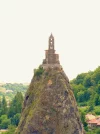
I was astounded. This, I read, was the remnant neck of an ancient volcano, the conical mountain itself having been long since eroded away. The fact that such a thing existed on the other side of the English Channel seemed incredible. Volcanoes, to me were exotic phenomena, far away. (Obviously the authors of this original French Larousse Encyclopaedia were influenced in their choice of illustration). I resolved, then and there, that one day I would visit Le Puy and climb to the top of that extraordinary marvel. It took me about 60 years, but in 2019 I did just that, crossing the world instead of the Channel.
I did a tour of France on my bike, a round trip to and from Roscoff ferry in Brittany. The itinerary was planned deliberately to pass through Le Puy at nearly the half-way point. Obviously I was not on Camino but I did cycle a few sections of various caminos - they are hard to miss in France. I stayed 2 days, booked into a comfortable self contained AirBnb in the centre.
St Michel d'Aiguilhe is situated some distance from the city centre, and this was my first view of it, seemingly a toy perched on the roof of a house.
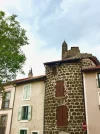
Well, before I climbed the 260 or so stone steps to the summit, I managed to reproduce the grandeur of that photo from long ago. A boy’s dream become reality. That day I probably took 50 photos. Like Mont St Michel, this was a wonder.
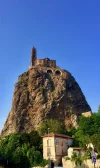 The staircase itself is remarkable as seen in this old engraving.
The staircase itself is remarkable as seen in this old engraving.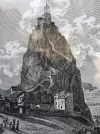
Going up is OK. Coming doown was hell on my knees.The chapel is beautiful.
...and a view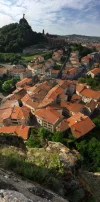
As my later education in geology progressed I became aware that exposed volcanic necks like this are by no means unique. The most spectacular occurrence would be in the aftermath of the eruption of Mt Pelée in Martinique 1902. A pyroclastic cloud, ie a superheated soup of gas, molten rock and glowing ash exploded out of the volcano and descended on the city of St Pierre at horrifying velocity, completely destroying it and killing the entire population except for a convict adequately shielded in his dungeon.
Then the mountain ejected its own volcanic neck, rising sometimes at 20m per day out of the crater to the terrifying height of nearly 300m. Eventually it collapsed under its own weight. Those are human figures at the bottom.
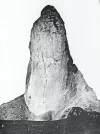
There are similar erosional examples to Le Puy. The most spectacular of all is probably in Sao Tome Principe, off the west African coast.
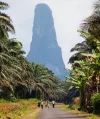

A satisfyingly hefty book about the history of the planet.
My parents knew I was interested in rocks and fossils, and this book certainly fed my appetite. There was of course a chapter all about volcanoes, and included in this was full page colour plate of the chapel of St Michel d'Aiguilhe in Le Puy perched on the summit of its immense tower of rock.
This is more or less the picture - I no longer have the book.

I was astounded. This, I read, was the remnant neck of an ancient volcano, the conical mountain itself having been long since eroded away. The fact that such a thing existed on the other side of the English Channel seemed incredible. Volcanoes, to me were exotic phenomena, far away. (Obviously the authors of this original French Larousse Encyclopaedia were influenced in their choice of illustration). I resolved, then and there, that one day I would visit Le Puy and climb to the top of that extraordinary marvel. It took me about 60 years, but in 2019 I did just that, crossing the world instead of the Channel.
I did a tour of France on my bike, a round trip to and from Roscoff ferry in Brittany. The itinerary was planned deliberately to pass through Le Puy at nearly the half-way point. Obviously I was not on Camino but I did cycle a few sections of various caminos - they are hard to miss in France. I stayed 2 days, booked into a comfortable self contained AirBnb in the centre.
St Michel d'Aiguilhe is situated some distance from the city centre, and this was my first view of it, seemingly a toy perched on the roof of a house.

Well, before I climbed the 260 or so stone steps to the summit, I managed to reproduce the grandeur of that photo from long ago. A boy’s dream become reality. That day I probably took 50 photos. Like Mont St Michel, this was a wonder.
 The staircase itself is remarkable as seen in this old engraving.
The staircase itself is remarkable as seen in this old engraving.
Going up is OK. Coming doown was hell on my knees.The chapel is beautiful.
...and a view

As my later education in geology progressed I became aware that exposed volcanic necks like this are by no means unique. The most spectacular occurrence would be in the aftermath of the eruption of Mt Pelée in Martinique 1902. A pyroclastic cloud, ie a superheated soup of gas, molten rock and glowing ash exploded out of the volcano and descended on the city of St Pierre at horrifying velocity, completely destroying it and killing the entire population except for a convict adequately shielded in his dungeon.
Then the mountain ejected its own volcanic neck, rising sometimes at 20m per day out of the crater to the terrifying height of nearly 300m. Eventually it collapsed under its own weight. Those are human figures at the bottom.

There are similar erosional examples to Le Puy. The most spectacular of all is probably in Sao Tome Principe, off the west African coast.







